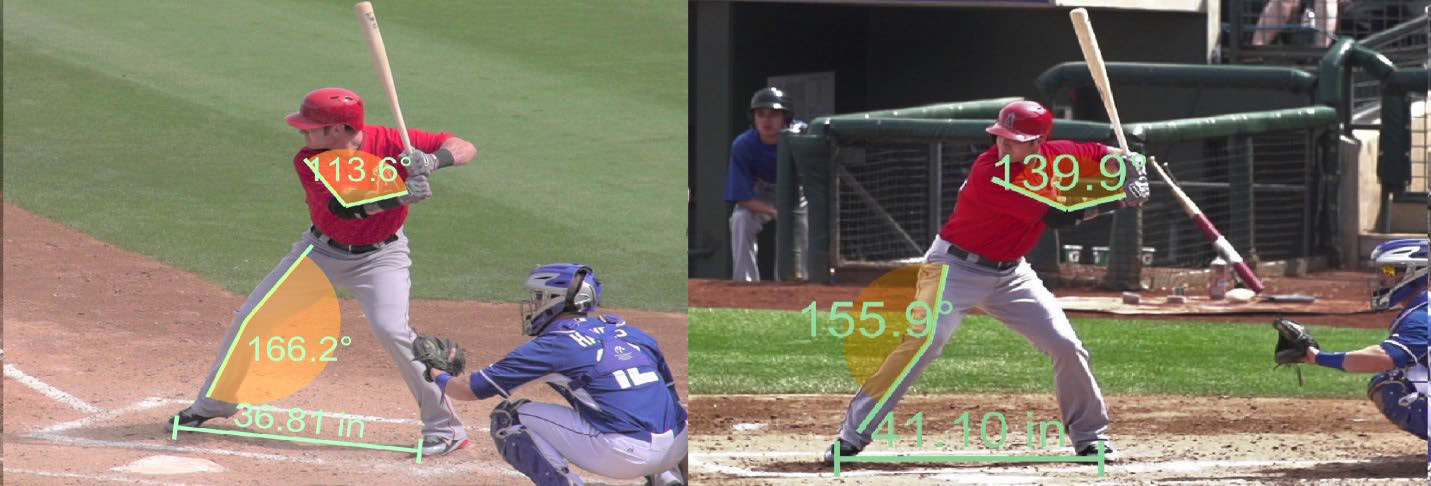Two Dimensional vs. Three Dimensional:
There has always been a substantial disconnect between the baseball guy and the bio mechanist. The baseball guy doesn’t believe there is anything that he can’t see using 2D simple observation, while the bio mechanist doesn’t believe there is much you actually CAN see using only 2D simple observation.
“When you look at an extended amount of video, trying to find something that’s mechanically wrong, it’s too easy to create an ‘impression’ of something that’s wrong that’s just not there” – Billy Ripken MLB Network. Hitting and pitching are three-dimensional activities and therefore require a three-dimensional measuring device. Below are a hitting and pitching three example of two-dimensional simple observations (from video) that demonstrate how easy it is to make conflicting or erroneous conclusions. A two-dimensional image (positional snapshot) does not even provide an accurate description of the true three-dimensional body position, and certainly not ANY information relating to the sequence of forces and movements that placed the body in that position or the inevitable resulting body forces and movements that will occur after that snapshot. What occurs in just a matter of milliseconds before and after any snapshot is an essential aspect of understanding human motion, and is especially important in the high-speed high-force movements encountered in baseball! It’s the movement that must be understood, not simply the position.

(The 2D camera eye perspective) Shows two separate side views of the same swing at the instant of foot strike in two dimensions. Even though the measurements were taken from the same hitter at the same time, they are not only different from each other but the fact is that neither measurement is accurate. These measurements were made from the perspective of the camera’s eye that distorts the image due to the angle and distance to the camera. They do not accurately model the hitter’s body’s segments.

(The 2D camera eye perspective) Shows three separate views of the same delivery at foot strike in two dimensions. Even though the measurements were taken from the same pitcher, at the same time, during the same pitch, they not only differ from each other, but none of the measurements describe the TRUE body position of the pitcher at foot strike. Again, these measurements were made from the perspective of the camera’s eye that distorts the image due to the angle and distance to the camera. 2D images do not accurately model 3D performance. See “teaching movement rather than position” in chapter 8, Building a Higher Performance Engine.
Pitch Out
A number of well-known pitching coaches have confided in us over the years, admitting that “we aren’t sure what good mechanics are anymore”. What they have come to realize is that they can’t see what they once thought they could, and that the only way to reliably know if a pitcher has good mechanics is to perform a three dimensional kinematic and kinetic analysis.

Demonstrates how a two-dimensional simple observation can give rise to an optical “illusion”. This side view shows a pitcher that is said to have a tremendous glove arm retraction, a tuck/pull of the glove arm. In reality, the front arm DOES NOT actually tuck or pull, but rather the glove arm wrist continues to track forward until AFTER ball release. The illusion is caused by the upper body “catching up” to the glove arm.


Many aspects of the hitting and pitching motion are simply too fast to see and yet too important to miss. Imagine trying to see hip, shoulder or arm/s velocities. More importantly, trying to see the degree of external/internal arm rotation, forearm supination/pronation (pitching) or bat speed and bat quickness (hitting) in real time.

Shows an image where an MLB professional “saw”, through 2D observation, 20 degrees of peak hip/shoulder separation. Our 3D motion analysis measured nearly three times that. The professional missed the peak hip/shoulder separation (trunk “twist”) by almost forty degrees!!!
The only way to measure human movement accurately is through the use of multiple, simultaneous, high speed video sequences recorded from different directions, and then to transform those multiple two-dimensional frame sequences (still images), into three-dimensional reconstructed or animated computer images by the process of digitizing and computation. The resulting images show the true body position and body movement at critical phases in the delivery. Graphs of specific motion parameters are generated for each phase and our analysis uses numerical measurements made from these graphs. Only by converting multiple 2D images to a true 3D representation of motion, it is possible to measure and know an athlete’s true body mechanics.
